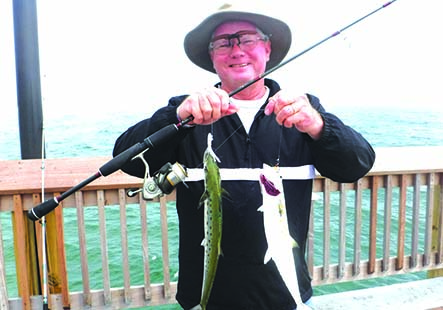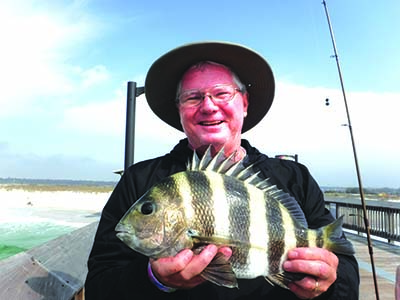Pier & Shore Fishing Outlook
 Pier & Shore Fishing Outlook
Pier & Shore Fishing Outlook
By David “The Pierpounder” Thornton
Well, winter’s grip is slowly loosening from our area. And the Gulf water temperature has rebounded into the middle to upper 60s. As a result, resident fish and other sealife are becoming more active even as other species stream into the warming near shore waters. Right on cue, the first Spanish mackerel arrived on scene at the Gulf State Park Pier, and Alabama Point jetty. That trend has been growing, and reports of more numerous catches of 12” to 18” mackerel are being mentioned to our east from the Florida Panhandle piers. Typically a ‘flood’ of lean and very hungry Spanish mackerel make their way along the Alabama coast through the end of March.
The Gulf State Park Pier (even with its reduced length) is a good place to intercept this migration. Recent catches have been getting more dependable, practically every day since they arrived. Of course rough water may curtail the bite for a few days until we get another break in the weather, which will allow the water to clear some. And lurking close behind the mackerel schools are the Spinner and Blacktip and Sandbar sharks that keep mackerel fishermen on their toes. At least the pier is no longer ‘chumming’ the water with hundreds of mackerel carcasses. But the sharks are at times still an issue to be dealt with.
Most mackerel anglers from the pier throw lures on medium to medium heavy class 7 to 8 foot rods. The ‘average’ reel is a 3000 or 4000 series spooled with 150 to 250 yards of 10 or 12 pound monofilament line, or 15 to 20 pound braided line.
The added ‘heaviness’ of the rod and line are specifically to pull a hooked mackerel away from any pursuing sharks. There is another school of thought though, and that is to open the bail and allow the swift and agile mackerel to ‘out-swim’ the larger shark. This tactic works more often than not, and allows the angler to fish lighter line and gear for more enjoyment.
But IF you mackerel fish, get used to the idea some of your lures will be sacrificed to either mackerel or shark teeth. Most Spanish mackerel anglers simply use a foot long ‘shock leader’ of heavy, clear monofilament line (about 40 pound). Usually no swivel is added, because the mackerel often mistake that for a moving prey item and bite it. So good knot tying becomes critical to connect the heavy mono leader to the lighter main line with a less visible, small knot.
A Double Uni (aka Uni-to-Uni ) knot works well, but I find a Surgeon’s Knot faster and easier to tie, especially during a ‘hot’ mackerel bite.
This time of year, the Spanish mackerel tend to stay deeper in the water column, so the ¾ ounce Gotcha plug is a favorite lure, especially for ‘beginners’. But this lure has a bad reputation of hooking anglers as well as fish with its dual swing treble hooks.
Be ever-mindful of your back swing when casting, or better yet, cast underhand. This tactic is much easier now with the new slanted railing on the pier which makes it more comfortable for most anglers to lean forward toward the water. Always be sure to compensate for the wind and current and cast perpendicular to the pier, so anglers’ lines do not cross. That is inevitable to some degree when fishing a crowded pier, even with social distancing. But you will make friends faster if you do, and enemies faster if you don’t!
The 5/8 and ¾ ounce leadhead jigs with white or chartreuse paint and ‘hair’ (like the locally produced “Looney jigs) are much less expensive than other plugs or spoons, and at least as effective for catching mackerel. And they are safer with only a single, fixed hook to watch out for.
As the sheepshead bite winds down with the spawn centered on the full moon of March 28, anglers may be otherwise entertained with increasing numbers of pompano. Most pompano are caught in the ‘surfzone’ between the beach and longshore sandbar. This should help spread some fishing pressure away from the shortened ‘end’ of the pier when the Spanish mackerel are running. In fact this time of year it’s not uncommon for anglers to catch a limit of mackerel, then switch location and tactics for a limit of pompano in the same day.
As with fishing from the beach, most pompano anglers use a set rig baited with pieces of shrimp and perhaps Fishbites or Fishgum. Just keep in mind the one-rod-in-use-at-a-time rule on the pier may make for some long waits between bites if the pompano are not near the pier. To remain more actively fishing, many savvy anglers prefer to jig for their pompano. This allows the angler to cover much more water, and not be locked down in a single location while waiting for the fish to come to them.
Surf anglers have been finding an increasing number of pompano, along with a fairly dependable whiting bite, and even a few smaller black drum, redfish, and sheepshead. All of these are excellent eating and add a bit of variety to the creel. But pompano will be getting more and more attention as we move farther into spring!
Pictured: The Pier Pounder says Spanish mackerel numbers are increasing almost daily, and the sheepshead spawn/bite is in full swing along the Alabama Coast.

